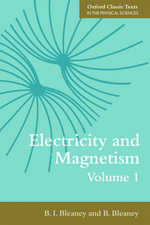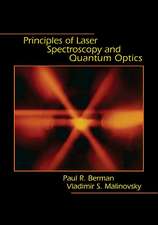Theoretical and Experimental Studies on Non-Fourier Heat Conduction Based on Thermomass Theory: Springer Theses
Autor Hai-Dong Wangen Limba Engleză Paperback – 27 aug 2016
| Toate formatele și edițiile | Preț | Express |
|---|---|---|
| Paperback (1) | 632.22 lei 6-8 săpt. | |
| Springer Berlin, Heidelberg – 27 aug 2016 | 632.22 lei 6-8 săpt. | |
| Hardback (1) | 638.24 lei 6-8 săpt. | |
| Springer Berlin, Heidelberg – 18 feb 2014 | 638.24 lei 6-8 săpt. |
Din seria Springer Theses
- 18%
 Preț: 997.88 lei
Preț: 997.88 lei -
 Preț: 389.88 lei
Preț: 389.88 lei - 15%
 Preț: 646.94 lei
Preț: 646.94 lei - 18%
 Preț: 943.43 lei
Preț: 943.43 lei -
 Preț: 399.29 lei
Preț: 399.29 lei - 18%
 Preț: 944.99 lei
Preț: 944.99 lei - 15%
 Preț: 636.80 lei
Preț: 636.80 lei - 18%
 Preț: 941.05 lei
Preț: 941.05 lei - 15%
 Preț: 643.16 lei
Preț: 643.16 lei - 15%
 Preț: 642.68 lei
Preț: 642.68 lei - 18%
 Preț: 1103.62 lei
Preț: 1103.62 lei - 20%
 Preț: 558.83 lei
Preț: 558.83 lei - 18%
 Preț: 1112.30 lei
Preț: 1112.30 lei - 18%
 Preț: 944.19 lei
Preț: 944.19 lei - 18%
 Preț: 1109.92 lei
Preț: 1109.92 lei - 18%
 Preț: 1217.27 lei
Preț: 1217.27 lei - 15%
 Preț: 640.06 lei
Preț: 640.06 lei - 15%
 Preț: 636.45 lei
Preț: 636.45 lei - 15%
 Preț: 640.06 lei
Preț: 640.06 lei - 15%
 Preț: 640.88 lei
Preț: 640.88 lei -
 Preț: 389.70 lei
Preț: 389.70 lei - 20%
 Preț: 563.91 lei
Preț: 563.91 lei -
 Preț: 393.35 lei
Preț: 393.35 lei - 15%
 Preț: 637.93 lei
Preț: 637.93 lei - 15%
 Preț: 641.85 lei
Preț: 641.85 lei - 18%
 Preț: 1225.94 lei
Preț: 1225.94 lei - 20%
 Preț: 551.36 lei
Preț: 551.36 lei - 18%
 Preț: 1229.10 lei
Preț: 1229.10 lei - 15%
 Preț: 639.25 lei
Preț: 639.25 lei - 18%
 Preț: 999.45 lei
Preț: 999.45 lei - 15%
 Preț: 640.06 lei
Preț: 640.06 lei - 18%
 Preț: 1220.45 lei
Preț: 1220.45 lei - 18%
 Preț: 1116.26 lei
Preț: 1116.26 lei - 18%
 Preț: 1110.72 lei
Preț: 1110.72 lei - 18%
 Preț: 1000.87 lei
Preț: 1000.87 lei - 18%
 Preț: 891.17 lei
Preț: 891.17 lei - 15%
 Preț: 640.06 lei
Preț: 640.06 lei - 5%
 Preț: 1154.07 lei
Preț: 1154.07 lei - 15%
 Preț: 635.96 lei
Preț: 635.96 lei - 15%
 Preț: 640.88 lei
Preț: 640.88 lei -
 Preț: 387.20 lei
Preț: 387.20 lei - 18%
 Preț: 1109.92 lei
Preț: 1109.92 lei -
 Preț: 385.25 lei
Preț: 385.25 lei -
 Preț: 385.25 lei
Preț: 385.25 lei - 18%
 Preț: 1112.30 lei
Preț: 1112.30 lei - 18%
 Preț: 999.45 lei
Preț: 999.45 lei -
 Preț: 386.99 lei
Preț: 386.99 lei - 15%
 Preț: 637.13 lei
Preț: 637.13 lei - 20%
 Preț: 554.21 lei
Preț: 554.21 lei - 20%
 Preț: 555.59 lei
Preț: 555.59 lei
Preț: 632.22 lei
Preț vechi: 743.79 lei
-15% Nou
Puncte Express: 948
Preț estimativ în valută:
120.98€ • 129.36$ • 100.87£
120.98€ • 129.36$ • 100.87£
Carte tipărită la comandă
Livrare economică 18 aprilie-02 mai
Preluare comenzi: 021 569.72.76
Specificații
ISBN-13: 9783662513378
ISBN-10: 3662513374
Pagini: 126
Ilustrații: XIV, 112 p. 93 illus., 25 illus. in color.
Dimensiuni: 155 x 235 x 7 mm
Greutate: 0.19 kg
Ediția:Softcover reprint of the original 1st ed. 2014
Editura: Springer Berlin, Heidelberg
Colecția Springer
Seria Springer Theses
Locul publicării:Berlin, Heidelberg, Germany
ISBN-10: 3662513374
Pagini: 126
Ilustrații: XIV, 112 p. 93 illus., 25 illus. in color.
Dimensiuni: 155 x 235 x 7 mm
Greutate: 0.19 kg
Ediția:Softcover reprint of the original 1st ed. 2014
Editura: Springer Berlin, Heidelberg
Colecția Springer
Seria Springer Theses
Locul publicării:Berlin, Heidelberg, Germany
Cuprins
Introduction.- Thermomass theory for non-Fourier heat conduction.- Experimental investigation of thermal wave and temperature wave.- Experimental proof of steady-state non-Fourier heat conduction.- Conclusions.
Notă biografică
Hai-Dong Wang received his Ph.D. degree in Power Engineering and Engineering Thermophysics from Tsinghua University, China in 2012. Currently he works as a post-doctor at the Institute of Engineering Thermophysics, School of Aerospace, Tsinghua University, China.
Textul de pe ultima copertă
This book mainly focuses on the theoretical and experimental study of non-Fourier heat conduction behavior. A novel thermomass theory is used as the theoretical basis, which provides a general heat conduction equation for the accurate prediction of non-Fourier heat conduction. In order to prove the validity of this thermomass theory, a large current was used to heat the metallic nanofilm at the minimum temperature of 3 K. The measured average temperature of the nanofilm was notably higher than the prediction of Fourier’s heat diffusion equation, while matching well with the general heat conduction equation. This is the first time that steady non-Fourier heat conduction has been observed. Moreover, this book concerns the role of electron-phonon interaction in metallic nanofilms, which involves the breakdown of the Wiedemann-Franz law at low temperatures and interfacial thermal resistance at femtosecond timescales. Readers will find useful information on non-Fourier heat conduction and the latest advances in the study of charge and heat transport in metallic nanofilms.
Caracteristici
Nominated as an outstanding Ph.D. thesis by Tsinghua University, China Presents a comprehensive introduction to the novel Thermomass theory, which is capable of quantitatively predicting the energy transport in nano-materials, including non-Fourier behaviors Provides original data of thermal properties of metallic nanofilms in a wide temperature range and gives a full explanation based on kinetic theory Includes supplementary material: sn.pub/extras


















